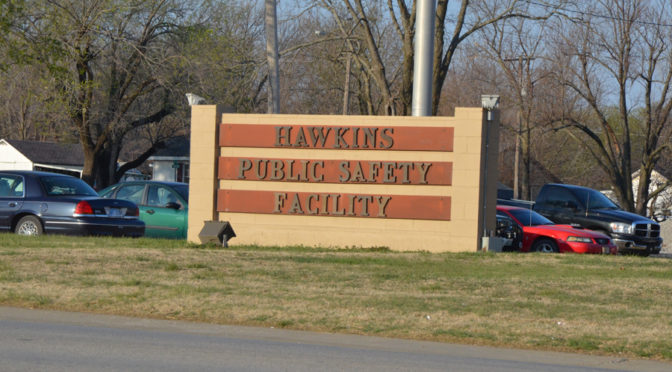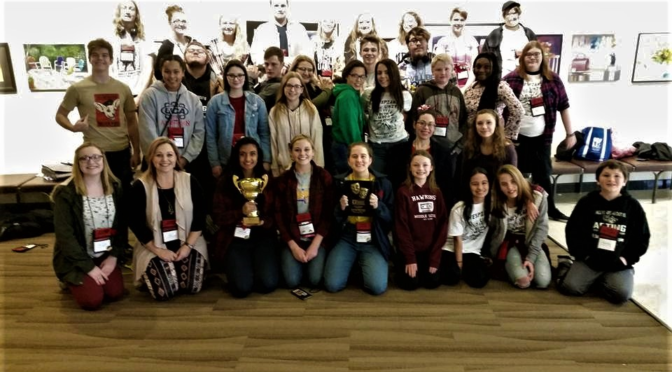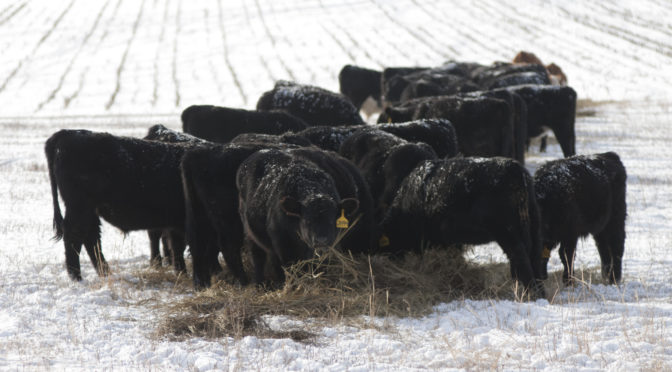All posts by Submitted Story
Fort Scott Police Department Daily Report Jan. 29
Andrew Callahan To Play In Shrine Bowl
Golf Course Advisory Board Meets February 1
Governor Issues Proclamation To Pray And Fast Jan. 30
Kansas Governor Sam Brownback on Friday issued a proclamation declaring Tuesday, January 30, 2018 a “Day of Prayer and Fasting” in Kansas, and issued the following statement:
“President George Washington, in his 1795 Proclamation for a Day of Public Thanksgiving called on Americans “to acknowledge our many and great obligations to Almighty God and to implore Him to continue and confirm the blessings we experience.””
“I personally feel blessed by the time I have spent serving our great state and would like to observe a time of prayer and fasting before God takes me on to the next part of my journey. I invite all Kansans to join me as we pray for our state and our nation.”
This is Governor Brownback’s final proclamation signed as Governor of Kansas.
Bourbon County Commission Meeting Agenda Jan. 30
11:00-11:15-Justin Meeks-acquisition of real property
12:00-1:30-Commissioners gone to lunch
2:00-Review deposit process for R & B Accounts
Tax sale/timeline
Health Insurance dept. head meeting update
Petition on drugs
Response from landowners about rock quarry
Fire Districts
2:30-Employee Handbook
1st District is Lynne Oharah,2nd District-Jeff Fischer,3rd District-Nick Ruhl, County Clerk-Kendell Mason.
Justifications for Executive Session:
Personnel matters of individual non-elected personnel
Consultation with an attorney for the body or agency which would be deemed privileged in the attorney-client relationship
Matters relating to employer-employee negotiations whether or not in consultation with the representative(s) of the body or agency
Confidential data relating to financial affairs or trade secrets of corporations, partnerships, trusts and individual proprietorships
Preliminary discussions relating to the acquisition of real property
Matters relating to the security of a public body or agency, public building or facility or the information system of a public body or agency, if the discussion of such matters at an open meeting would jeopardize the security of such public body, agency, building, facility or information system
FSHS Thespians Attend State Festival, Earn Honors
Submitted by Angie Bin
The Fort Scott High School Thespian Troupe #7365 gleaned several honors from the annual KS State Thespian Festival January 4-6, at the Century II Center in Wichita.

Twenty-six students attended with Thespian Director Angie Bin and sponsor Mark Bergmann. In addition, six Fort Scott Middle School Drama Club members attended on January 6, with sponsor Mary Jo Harper.
The troupe earned the highest honor awarded to Thespians in Kansas, the Gold Honor Troupe Award. To achieve this, troupe Historian Karina Kantilal, a junior, presented a notebook documenting the group’s productions, community involvement, and activities. The FSHS troupe also received a plaque for its 10-year anniversary as a troupe.
State Board Representatives senior Xavier Watkins and junior Hunter Adamson helped organize and lead the festival. Adamson received the honor of being elected by KS Thespian Directors to serve as one of five State Board Officers for the coming year.
“Getting the opportunity to hold the position of State Thespian Officer is such an honor,” Adamson said. “In the year to come, I hope to advocate for the importance of theatre for young people and bring about an awareness of the strength of the theatre department.”
As part of Adamson’s duties, she will attend leadership classes at the International Thespian Festival in Lincoln, Neb., in June and meet with the other officers throughout the year. She will then lead all state board representatives from Kansas schools to plan next year’s festival and will be in charge of the 2019 Festival.
Over the three-day festival, students also attended workshops and classes covering all aspects of theatre including acting, dance, technical theatre, theatre advocacy, stage combat and other related topics. Bin taught a workshop entitled “Let’s Play! Growing Theatre Kids,” using her research on children’s theatre to teach other schools how to cultivate a love for theatre among younger children in their communities.
Junior Darrick Green said, “I attended the Musical Theatre Stars dance workshop. It really showed me how profound these Broadway stars really are, how hard they have to work, how difficult choreography is and how much effort actually has to be released to achieve greatness.”
Students also watched productions of the top musicals and plays in the state, chosen to perform at the festival.
Junior Alyx Brooks remarked, “As usual, all of the workshops and plays were wonderful, however, one of my favorite workshops was a lighting workshop that helped me understand the different energies of lighting.”
Many students competed in individual events including sophomore Mesa Jones, junior Mary Gladbach, and senior Grant Coffman in Musical Solo; juniors Daniela Belcuore and Brooklyn Lyons in Musical Duet; and Brooks and Adamson in Duet Acting. The entire troupe competed in late night events including Improvised Acting, Speed Charades, and Creative Costuming.
The FSHS troupe plans to attend the International Thespian Festival at the University of Nebraska in Lincoln, June 25-30. Members are working throughout the year to earn the approximately $750 registration fee to attend.

KState Extension: Regional Farmers’ Market Workshop Scheduled for Chanute
Submitted by Krista Harding
The interest in purchasing locally grown food is strong. Many consumers are looking to buy farm-fresh items that have been picked at the peak of ripeness, in most cases that very day! Have you ever thought about trying your hand at selling a product at a local farmers’ market? If so, you will want to plan to attend the regional farmers’ market workshop planned for our area.

The Kansas Department of Agriculture, K-State Research and Extension and the Kansas Department of Health and Environment are hosting a farmers’ market workshop set for February 10, in Chanute at the Mid-West Fertilizer Agronomy Center – 3030 S. Santa Fe.
The farmers’ markets are a great avenue for growers to market their products. The market allows growers to have face-to-face interaction with consumers. However, there are legal, safety and financial considerations that growers need to understand before choosing to sell at a farmers’ market. The regional workshop topics will cover topics that growers need to know about before selling.
Highlighted workshop topics include:
Vendor Marketing and Communications
Growing in High Tunnels 101
Regulations on Selling Meat, Eggs and Poultry
Sales Tax for Vendors
KDA’s Division of Weights and Measures will also offer free scale certification at the workshop for attendees.
Registration for the workshop is now open and is $20 per participant. Registration includes lunch; however, lunch will only be guaranteed to those participants who register by February 1. Registration forms can be found at FromtheLandofKansas.com/FMWorkshop or at any of the Southwind Extension District office locations in Erie, Fort Scott and Iola.
Onsite registration will open at 8:30 a.m. and the workshops will begin at 9 p.m. and conclude by 3 p.m.
In addition to this workshop, local growers are encouraged to attend the 2018 From the Land of Kansas Annual Meeting and Farmers’ Market Conference on March 1 and 2, in Manhattan. Registration is open at FromtheLandofKansas.com/FMConference and will close February 19.
Krista Harding is a K-State Research and Extension Agricultural agent assigned to Southwind District. She may be reached at [email protected] or 620-244-3826.
KState Extension to Host Poultry Grower Meeting
Submitted by Christopher Petty
You may have heard that Tyson Foods has had an interest in constructing a processing plant in Kansas. While there are no immediate plans to do so, it may be a possibility in the future. Farmers within an approximate 60 mile radius of the processing facility may be able to become contract poultry growers.

To learn what it might be like to be a contract poultry grower, plan to attend a poultry grower meeting on Thursday, January 18, beginning at 6 p.m. at the Thayer Senior Center in Thayer, Kan. This program is hosted by the Southwind Extension District of K-State Research and Extension and the Allen and Neosho County Farm Bureaus. The program will feature K-State Research and Extension Poultry Specialist Dr. Scott Beyer. Dr. Beyer will be on hand to discuss a variety of topics such as a typical day in the poultry production, contracts, rules and regulations, management and facilities.
Space is limited, so please call the Southwind Extension District Erie Office at 620-244-3826 to register. For additional information, contact Southwind Extension District Agent for Livestock Production and Forage Management, Christopher Petty by e-mail at [email protected].
K-State Specialists share tips for managing livestock in winter
Reducing animals’ stress during cold periods is a key goal
Livestock producers are entering a time of year that, because of winter weather, can often be challenging for maintaining the health of their herds, but a host of management steps and best practices can help to get the animals through the tough times.
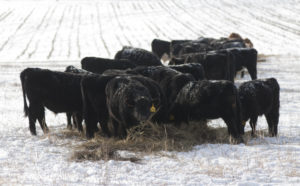
“Talking to a regional climatologist, we foresee a lot of fluctuation in weather,” said A.J. Tarpoff, a beef veterinarian with K-State Research and Extension. “The fluctuations from warm to cold are stressful on any animal, so you have to be ready for that fluctuation.
“If it gets cold and it stays cold, we can manage that very easily. The animals get used to the cold, dry environment. But when we start mixing warm to cold, and a little bit of moisture – in other words, we combine wind, cold and a wet animal — that leads to a little bit of trouble.”
Livestock that can be housed indoors — such as chickens, swine and dairy cattle – may be protected from severe elements, but keeping them properly ventilated can be challenging.
“It’s hard to keep the fans and the ventilation adjusted appropriately because the incoming air is still somewhat warmer during the day, but then it cools off during the night as we get the different weather fronts coming through,” said Joel DeRouchey, a livestock specialist with K-State Research and Extension.
DeRouchey notes that fluctuations in indoor temperatures can cause mortalities in herds because the animals get stressed from the roller-coaster shifts.
“It’s just like humans, from the standpoint if they’re going through any stress, changes in the outside temperature leads to humans developing respiratory challenges,” he said. “It’s the same for livestock, whether they’re inside or outside.
“The most important thing is maintaining a constant temperature. The goal is to bring animals inside to protect them from the elements, so we need to make sure our ventilation systems are managed correctly to provide that ideal environment.”
DeRouchey said that indoor ventilation also is important to keep air moisture, odor and nitrogen levels low. For animals kept outside in feedlots, Tarpoff said one key is to provide dry bedding.
“Cattle have the right winter coat for cold weather, but whenever it starts to get windy, wet and cold, especially on frozen ground, the cattle want to find a nice, dry area to lie down and rest,” he said.
“Bedding those pens, giving them the opportunity to lie down and rest decreases the stress on those cattle and allows them to increase their comfort level so they can perform at a high rate even in stressful conditions.”
Tarpoff added that a box scraper is an important part of the equation in feedlots. Pens should be scraped routinely to level frozen areas, which will help to reduce foot injuries and the reluctance of animals to move to feed and water.
In outdoor pastures, the two K-State specialists suggest portable windbreaks, which provide shelter and can help with basic biosecurity.
“When cattle congregate in one area of the pasture for a long period of time, you build up environmental contaminates from manure,” Tarpoff said. “So move the portable windbreaks to different locations in the pasture so that you decrease the environmental contamination, which is especially important for newborn calves and control of scours.”
DeRouchey notes that portable windbreaks can force cattle to walk out of low areas to water and feed.
“It doesn’t hurt those cows to walk out of those low areas,” he said. “From an environmental standpoint, once we start providing a lot of feed or stationary feeders in those low areas, the manure buildup and the sanitation degrades really fast.”
During severe cold periods, producers need to feed a little more hay or other forage so that the animals’ natural heat source – the rumen – can do its work. Cattle may be fed near windbreaks during times of extreme cold and snow, but DeRouchey notes that shouldn’t happen very often during the season.
Tarpoff added that water is equally important for livestock in the winter months as it is in the summer months.
“They are eating a lot more, so they need to be able to drink a lot more to balance the body’s homeostasis,” he said. “Check waterers regularly that they are not frozen over, there’s plenty of flow, and there’s plenty of volume for animals to drink from. A frozen tank can be detrimental to any livestock operation.”
The two K-State specialists also shared some ideas to help producers get themselves through the colder months. Specific to the upcoming calving season, one tip is to feed cattle in the evenings.
“Changing our feeding strategies to the evening hours, right at dusk, will increase the number of calves born during the daylight hours, which is when the producers are out checking those cattle more regularly,” Tarpoff said.
DeRouchey also reminded producers to make sure flashlights are in working order, and store extra batteries and clothing in case they get stranded or need to be out for extended periods in cold and snowy weather.
Story by:
Pat Melgares
K-State Research and Extension
www.ksre.ksu.edu
For more information:
Joel DeRouchey, [email protected], 785-532- 2280
AJ Tarpoff, [email protected], 785-532- 1255
KState Extension: New Year Resolutions for the Farmer
Submitted by: Carla Nemecek, Southwind Extension District, Director & Agent
Polls show that 88 percent of Americans make at least one New Year’s resolution. While resolutions can be as unique as the individual, the most popular resolutions are to eat healthier (55%), exercise more (50%), and lose weight (38%).

Although made with good intentions, most people fail to follow through in keeping their goals for the New Year. But that doesn’t mean our farmers and ranchers can’t be among the 20% of people who do actually achieve success with their resolutions.
Slow down. Farmers are notorious for being in a rush – always too much to do and not enough time to get it done. I realize a farmer’s day doesn’t always go according to schedule, but if you can slow down you may save yourself time in the long run. Remember, slow and steady wins the race.
Get organized. Get a new notepad or calendar to keep track of breeding dates, birthing dates, and dates that vaccinations were given. Personal experience says the intent to just remember that tag number and write it down once in the house is often forgotten. A handy calendar in the pickup or barn will encourage those things to be written down immediately.
Learn from past mistakes. I am guessing that many of us have something we wish we could change from the past year. Whether it be remembering a birthday or communicating to family or employees, try to avoid making the same mistake twice. Think about one decision you would change from the past year and make and create a plan to correct it for 2018.
Create a marketing plan. This could be for either a crops or livestock operation. Will you be ready to price grain when you reach your price objective? Do you have a price objective? Can you market your cattle in a more efficient manner and gain more profits? If you have a plan, you will be more prepared when the markets change.
Eat healthier. I am certainly not a nutritionist, but it doesn’t take one to tell you that a can of soda is not healthy. Look for ways to eat healthier and drink plenty of water. You are a valuable resource to your farming operation and to your family.
Change one thing. Surely there is something on your farm or ranch that you’ve intended to correct or fix. Maybe the fence is in need of drastic repair, or the driveway needs a new load of gravel. Either way, find that one thing that you’ve intended to do and get it done. Commit to having it accomplished by a specific date and stick to it.
Spend time with family. Kids grow fast and whether you are a parent or grandparent you surely realize the most precious gift is time. As the kid of a farmer, I can tell you that spending any time with Dad is valuable. Give them a ride in the pickup on the way to the field or let them ride in the passenger seat of the tractor or combine. While you have some one-on-one time, talk to them and slow down enough to listen. This advice is good for your spouse too!
Learn something new. Living in the technology age, there really isn’t a good excuse for not knowing what is going on in the world around you. If you haven’t figured out how to use the internet, ask someone to show you how. You will be amazed at the information and resources available to you.
Another year has passed, and here we are at the beginning of 2018. This is surely to be a year of many good memories and experiences. For me, I hope it is a year of Patience – my personal resolution to make me a better mom, wife, friend and co-worker. Happy New Year!
Fort Scott NHS Announces Launch of new Mobile App
Submitted by Fort Scott National Historic Site
Visitors to Fort Scott NHS in 2018 will have a new way of discovering the Fort’s resources and stories. The site is pleased to announce the launch of a new smart phone and tablet mobile app. The app features an interactive map, multiple historic and “behind the scenes” photos, interesting details about all of the buildings and furnished rooms, and helpful information on available services. Best of all, the app is free.
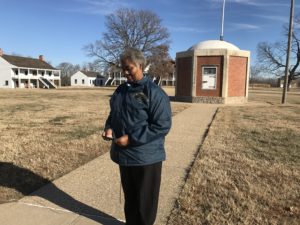
The app allows visitors to engage with the site in new ways and make discoveries right in the palm of their hand. It also increases the accessibility of the site. Individuals with limited mobility can explore photos of the rooms and exhibits that they may not be able to visit.
Audio description of tour stops and site features describe what is in each room for visitors with sight impairment. The interactive map shows where tour stops and features are located. Information about each stop “activates” in the app as a user approaches the locations. The map includes large font sizes, easily distinguishable walkways, and multiple zoom levels.
Other features of the new app include:
A calendar, which allows users to view upcoming special events and programs
A tour function, which assists visitors in taking a self-guided tour
A “Build-an-Itinerary” function, where users can create a personalized plan by saving favorite sites and events; visitors can even get alerts when they are near a saved site
Fort Scott NHS is excited to be adding this 21st Century method of serving visitors. The app will allow the Fort to reach the increasing number of people who use mobile devices when they travel, engage with tech-savvy audiences, and increase the accessibility of the site for more people.
The app is one in a series of official National Park Service apps that includes sites such as Grand Teton National Park, Independence National Historical Park, and Herbert Hoover National Historic Site.
The app is free of charge and at this time is available for iPhones, iPads, and iPod Touches. It requires iOS 9.0 or later and can be found on the Apple App Store. Search “NPS Fort Scott.” Users will need internet access to download the app, but once downloaded it can be used without connectivity.


